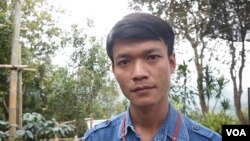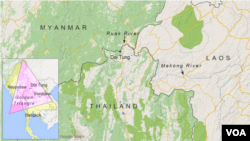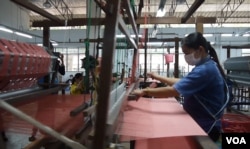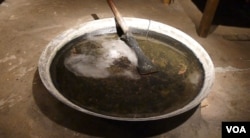As a child, Sopon Ayi sometimes went hungry when his father squandered the family’s money to feed his opium addiction. Sopon, now 29, is convinced he wouldn’t have gone to school, his father would still be miserable, and their village would be unsafe if they hadn’t given up the drug.
“Doi Tung had a lot of opium in the past,” Sopon said, referring to the village. “Almost everybody in my father’s generation was addicted to opium.”
Sopon, a coffee farmer, lives where Thailand meets Myanmar and Laos, an intersection that was the erstwhile capital of the global opium trade. The Thai royal family touts this region as a poster child for drug eradication, once at the heart of the notorious Golden Triangle but now, at least on the Thai side of the border, mostly opium-free.
The royal Doi Tung Development Project, which helped Thais like Sopon find jobs outside the poppy business, seems to have stood the test of time. What started off as a charity now turns a profit by selling coffee, pottery, clothes, and paper. The question is how much of this model can be replicated in today’s opium hotspots.
Myanmar remains the world’s No. 2 opium supplier, after Afghanistan.
In a report published Tuesday, the U.N. Office on Drugs and Crime (UNODC) said the amount of land used to grow poppies in Myanmar increased annually since 2006, but has been unchanged since 2013. Both Myanmar and Afghanistan are testing out the solutions that worked for Thailand, especially finding jobs instead of opium farming.
The Doi Tung project began in the late 1980s under the tutelage of Somdet Phra Srinagarindra Boromarajajonani, known as Thailand’s Princess Mother. Standing among the reforested hills of Chiang Rai, Dollaporn Rujiravong described how the Doi Tung project worked with locals to determine what skills they had.
“When the Princess Mother first came to this area, there were lots of problems, like people growing opium, there were drug traffickers, they did slash and burn,” said Dollaporn, senior communications manager at the Mae Fah Luang Foundation under Royal Patronage, which oversees the project. “But the Princess Mother didn’t see them as criminals. She thought, no one wants to be bad, they just don’t have the opportunity to be good.”
The foundation set up a drug rehabilitation center, as well as created jobs that ranged from growing coffee to weaving purses. The Doi Tung project’s deputy chief executive ML Dispanadda Diskul admitted the royal endorsement helped to diminish opium’s pervasiveness and lure locals away from the trade. But his group also had to earn Thais’ trust and ensure there was work to replace opium production, he said.
“At the end of the day, if the royal family or anyone can’t provide meaningful jobs, long-term alternatives, improved livelihoods, then it [means] nothing, right?” said Dispanadda, who is a member of the royal family. He estimates Doi Tung earns $15 million annually, of which 3-8 percent is profit.
Jeremy Douglas, UNODC representative for Southeast Asia and the Pacific, agrees that stamping out opium creates a vacuum unless a new income source replaces it. His office and other groups promote such alternative sources as planting cotton and indigo in Afghanistan, or tending goats and selling peanuts in Myanmar.
Of course these other countries, as well as Laos, don’t have the public relations power of a royal foundation. They also lack rule of law. While Thailand’s separatist groups are mostly in the south and away from the narcotics epicenter, Myanmar’s poppy fields overlap with the territory of armed rebels. Douglas said the UNODC successfully signed cease-fires with those militias to conduct its development projects, but the Taliban is another story.
“Afghanistan is extremely different and very challenging for different reasons,” he said. “It’s not a market access issue there, but security is severely compromised.”
Even with opium mostly out of the picture, Thailand is still addicted to drugs. Douglas said it has one of the biggest markets for methamphetamine in the world, at least one billion pills a year but likely much more. Thailand’s Office of the Narcotics Control Board reflects the fact that the drug problem hasn’t disappeared.
“Other drugs such as morphine and heroin rapidly took place of opium,” the board’s website says, “especially heroin which was easy to consume and easy to avoid detection and suppression.”



